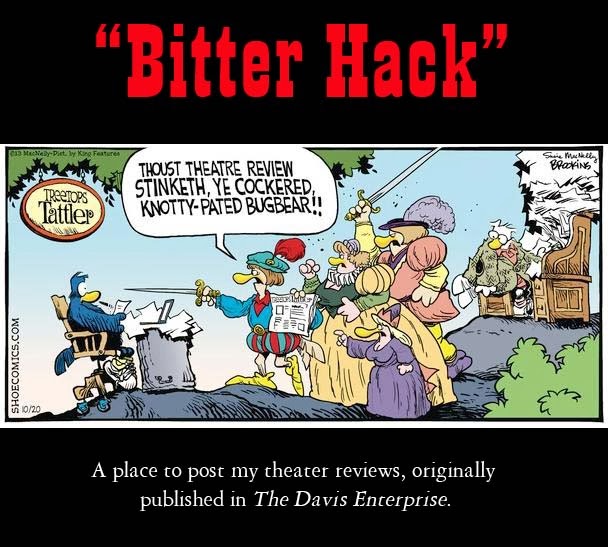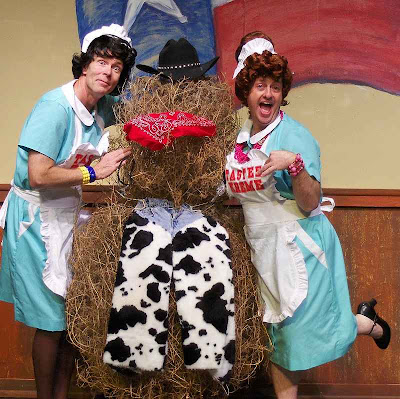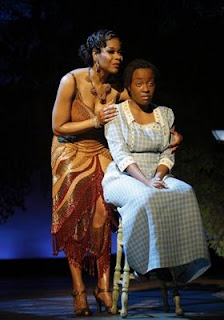
If you've been to the Davis Farmers' Market, attended a local political or charitable fundraiser, visited a nursing home, enjoyed the Woodland County Fair or had dinner at Ludy's Main Street BBQ during the past 30 to 40 years, chances are you're familiar with the Putah Creek Crawdads: our own purveyors of old-time acoustic folk music.
Even if you never realized the group had a name.
'You can't help but smile when you listen to the Putah Creek Crawdads,' said Crilly Butler, a longtime Davis resident. 'Their folksy and traditional tunes are always light and fun, and it's obvious that they love to play. I always enjoy catching the first strains of their music as I approach the Farmers' Market on Saturday morning.
'What a great way to start the day!'
I recently had the delightful experience of sitting in during a band rehearsal, at the home of psychiatrist Cap Thomson. When the group took a break, we sat around and discussed their long history.
It's easier said than done, digging through those dusty memories, to remember when the group began or how and when the name got chosen.
'This isn't a youthful rock band,' laughed Thomson, who plays banjo. The group spans an age range of 48 years, from 38 to 86.
Marc Faye, a farmer from Knights Landing, remembers that the four original members started playing together in the 1960s, when hootenanny music was popular and everybody seemed to play a guitar.
'Somebody asked us to be the opening act for a professional performer,' Faye said, 'and we had to have a name. We don't know when that was, but it was probably 1972.'
'Actually, that was after 1980, when we gave ourselves the name,' corrected attorney Oliver 'Chip' Northup, lead singer and guitarist. 'We were going to play for the Newman Club.'
Someone else insisted that 1972 was the closer date, and that it revolved around a talent show. Someone else was sure it was 1965; another member said no, earlier than 1965.
Hmmm.
As for the name itself, someone remembered that it came from the fact that the Unitarian Church was located on Putah Creek, which contained crawdads. Someone else thought it came from the line in the song: 'You get a line and I'll get a pole, and I'll meet you down at the crawdad hole.'
(Over the years, the name changed with the location: They've been the Cache Creek Crawdads, the Knights Landing Crawdads and a few other Crawdads along the way.)
'You can write anything you want about us, as far as our history is concerned, because none of us older folks is sure,' laughed the group, as a whole.
'We'd be afraid to challenge you!'
All were pretty much in agreement that the original band's distant genesis was a yearly gathering held by members of the Unitarian Church over at Dillon Beach, when everyone would sit around in the evening and sing music.
'I'd pick up a guitar once in awhile at Dillon Beach, and fiddle around with it,' said Ray Coppock, who taught himself to play as a kid, but hadn't touched the instrument in decades. 'My wife finally bought me my own guitar. I've never been a really good guitar player in terms of fingering, but I do the chording.'
Coppock, who has a degree in journalism and worked as a farm reporter for the Sacramento Bee - until he moved to Davis, to work as an information specialist for the university Ag Extension, until his retirement - never considered himself a singer, either.
'I'd never sung until I got with the Crawdads, but it was fun. I'm a baritone, and you don't 'hear' the baritones; but if they're gone, you miss them. I love doing the harmony.
'I stand on Chip's right side, because my good ear is on the left. I'm guided by Chip's melody.'
Nobody was more surprised than Northup's children, when he became a singer.
'It was accepted in my family that I couldn't carry a tune,' he joked.
But he decided to take a guitar class through the Davis Art Center; he learned to strum the guitar and began to sing to his younger children at night.
'It was a terrible ordeal for my older children.'
But he stuck with it.
'The voice was always there, and I always loved to sing, but I needed to develop an ear for music. I eventually learned how to stay on key all through a song.'
Northup credits Coppock for inspiring him.
'Ray is very, very precise, and very careful to work out a harmony that's satisfying for him on each of our songs. It's fun to listen to him while we're singing.'
Coppock also relies on the steady presence of Thomson, singing and playing banjo on his right.
Thomson, former director of Yolo County Mental Health and former director of the Sutter Center for Psychiatry, learned to play ukulele in high school; while in college, he bought a $5 guitar. But it was an impulse purchase in 1948 that set the stage for the Crawdads.
'I was in Oakland, at a pawn shop,' Thomson said, 'and I saw this old banjo hanging on the wall, kind of broken down. They wanted $8.50 for it, and I couldn't talk them down in price, but I bought it anyway.
'I'm still playing that old banjo.'
Thomson wasn't the only one to get a bargain on the instrument that would serve him for decades. Bass player Marc Faye - who was born in Knights Landing, but grew up on Kauai - learned to play the ukulele at 15, and he made music on that instrument through high school. In college, someone suggested he graduate to guitar.
'I went to pawn shops in San Francisco,' Faye recalled, 'and found a Martin 0018 for $35. I played guitar until the '60s, when everyone else was playing guitars.'
A jazz-playing friend suggested that Faye try accompanying his group on bass. The friend owned three basses, and Faye borrowed one and began working with other groups, as well.
'I had so much fun doing it, I wouldn't give the bass back to him ... so the rascal charged me $150 to buy it. Any group was glad to have a bass, and I was the only bass in town.
'It was the best $150 I ever spent.'
Faye still plays that instrument today.
The Putah Creek Crawdads became more organized several years ago, when Wayne Ginsburg, a retired English and journalism teacher, joined the group.
'I met the group through Rotary, and through politics,' Ginsburg explained. 'I taught at least one of Marc's sons, and I kept running into Marc and Cap at various meetings. Chip was a member of the school board about the time I arrived, but I never met Ray until a Rotary function, when the group was playing and invited me to sit in.
'A month later, Marc invited me to be at another function.'
Ginsburg started playing violin in fourth grade in Fresno, and continued through seventh grade. But as he reached high school, violin was 'no longer cool'; he taught himself to play guitar and took some lessons. But he abandoned music about halfway through college.
'When my son was ready for me to force him to take Suzuki violin, I got out a couple of inherited violins and participated with him for a year or two.
'When he forced me to give that up, I didn't do much of anything again until about two years before I retired.'
Scared of having nothing to do in retirement, Ginsburg did something he'd always wanted to do: He bought a mandolin and started taking lessons. Two years later, he joined the Crawdads and took over arranging the group's gigs. Booking had been fairly haphazard up to that time, but with Ginsburg's many years in social organization, he knew how best to market the group.
About six months before Ginsburg joined, Kate Laddish also became a member of the Crawdads.
'Someone erroneously told these young fellows that I played fiddle,' said the 30-something geologist and educator.
'I didn't.
'I was mostly playing guitar at that point. I hadn't taken a violin lesson since eighth grade, but they invited me to a rehearsal. I arrived with my guitar, which I thought was the instrument I was actually playing, and I said 'I don't actually play fiddle.' I think it was Marc who said 'But you have one, right?' It was my violin.
'I had wished that I played fiddle ... and it turned out that I did. Sort of.'
'Kate has a sensitivity about the way a song should be presented and performed,' Faye said. 'We used to just hack away at it, but we've become more 'performers' now. We're working on getting the hang of this thing.'
'I was totally flattered by what Marc said. It was so much nicer than 'Kate's so bossy, she won't shut up,' ' laughed Laddish, who cannot remember a time when music wasn't a big part of her life.
'Music was always playing in our house, and some of my earliest memories involve music.'
She started taking violin lessons in second grade, in the Berkeley public school system.
'That was the instrument I chose, because a friend played violin. The second song I ever learned how to play was the main theme to 'Star Wars.'
'I think one strength I do have is being able to essentially step outside, and observe what we're playing, and how we sound as we're doing it: to be a participant and an observer, to hear when something really works, and be able to say, 'Oh, that was great; we need to remember to do that.'
'Or say, 'I know this is the way we've always done this, but we always seem to trip up on it.'
'That's one thing I bring to the group.'
Watching the Crawdads perform at Ludy's, it's easy to envision a group-think taking place, as Coppock leans into Northup on the harmonies, and Laddish conducts with her bow, her foot or a certain look in her eye. These musicians have a nonverbal communication that works well for them.
And even after all these years, they continue to work on improving each show.
'I won't say Ludy's inspires us to greatness, because that implies greatness is attainable,' Laddish laughed. 'But I think something gels whenever we play at Ludy's. We sound better.
'Although it could be the beer.'
Enterprise beer columnist Michael Lewis recently told Thomson, 'You're always fun, and the marvelous thing is that you haven't improved a bit.'
'It sounds like a mean comment,' Lewis said, when I requested clarification, 'but I guess I meant they've remained delightfully the same over the many years that I've enjoyed their music.'
'The Putah Creek Crawdads have been an integral part of innumerable special events all over Yolo County for years,' said longtime Davis public events fixture Bob Bowen. 'Their music always brings a smile to my face.'
The group performs some 40 to 50 times a year, often in retirement homes or Alzheimer's facilities.
'Our residents absolutely love the Crawdads,' said Karen Wright, activities director at St. John's Retirement Village, in Woodland. 'We usually have them for our monthly social hour. They're great.'
Joan Callaway and Nancy Keltner, co-founders of All Things Right & Relevant, have had many dealings with the Crawdads through the years.
'I don't know how many times I've called them for one cause or another, and they've always been willing to perform,' Callaway said.
'It's sure a two-way street,' Keltner said. 'The joy they give, and the joy they get. You can just see it: They have so much fun doing it.'
The Crawdads never have made money performing all these years.
'We've never taken any money at all,' Ginsburg said. 'One time just after I joined, I think, the budget account go so big, about $1,500, so we found a particular charity group that was important to somebody. But none of us has taken any personal money out of it.'
Northup reminded him that they once took some of the funds and took their wives out to dinner; another time they bought an amplification system. ('And matching shirts!' Laddish chipped in.)
A recording is in the works now: This project began a few years ago, and the editing is taking longer than anticipated. But the resulting CD will be available. Eventually.
The Putah Creek Crawdads are one of those little gems that make living in Davis so special. They've been making us smile for decades ... and with the love these guys have for what they do, I'm sure they'll continue to entertain for many years to come.
Lee Riggs, of the musical group Riggity Jig, sums it up perfectly: 'It's always a fun time when the Crawdads play. They make the kind of music that makes you smile.
'And that's the point, isn't it?'
 Drive around Davis these days, and you'll see carpets of fallen leaves waiting to be swept up.
Drive around Davis these days, and you'll see carpets of fallen leaves waiting to be swept up.












